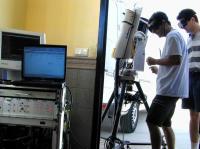Apr 27 2010
Joint work to develop the Spanish and Portuguese Aerosol Lidar Network (SPALINET), which uses laser technology for studying the atmospheric aerosols, by 10 scientific institutions from Portugal and Spain is in progress.
 SPALINET under development
SPALINET under development
They plan to homogenize and improve the measurement quality that would help in gaining better insight into the manner in which these particles scatter in the sky over the Canary Islands and the Iberian Peninsula.
This collaborative project aims to analyze aerosols that are suspended solid particles formed by humans or originating from natural sources like dust storms or volcano emissions. The project has attracted significant interest for analyzing the way pollutants are dispersed or testing models for weather forecast.
Satellites like the ones carried by NASA’s CALIPSO and ICESAT can incorporate the Light Detection And Ranging (Lidar) system. Lidar can also aim towards the atmosphere from mobile or fixed stations or the Earth. The SPALINET has aimed the Lidar on to the atmosphere in the Canary Islands and the Iberian Peninsula.
The Geophysics Centre of Évora in Portugal during March 2010 emerged as the tenth scientific institution that joined the SPALINET. This system functions like a traditional radar, but emits laser light rather than using radio waves, with the atmospheric particles reflecting the laser light that is subsequently redetected through an optical system.
The European Aerosol Research Lidar Network (EARLINET)-Advanced Sustainable Observation System (ASOS) project was formed to support the EARLINET. The EARLINET-ASOS is financed by the European Union’s 6th Framework Programme as an instrument for the measurement of the aerosols’ distribution in time and space at the continental level. The teams working on the initiative will meet in the Évora city in Portugal in the near future.
SPALINET was formed during 2007 for reinforcing and complementing the EARLINET that is the European scientific institutions’ voluntary association established three years back for conducting research on atmospheric aerosols.
The Lidar stations’ quality control is maintained by the Spanish and Portuguese network that also makes common regulations pertaining to the operation of the instruments and data recording. SPALINET helps in conducting measurements in regions that the European network does not cover like the Canary Islands critically located for analyzing phenomena like the Saharan dust movement.
The team at the Atmospheric Physics Group at the Andalucia Environment Centre with University of Granada and Andalucía Regional Government, Medioambientales y Tecnológicas (CIEMAT), Centro de Investigaciones Energéticas, the Energy, Environmental and Technological Research Centre (CIEMAT), and the UPC are members in both networks.
The IEEE Transactions dealing with Geoscience and Remote Sensing had recently published some of the climate models pertaining to aerosols scattering over the Peninsula, along with the SPALINET details.